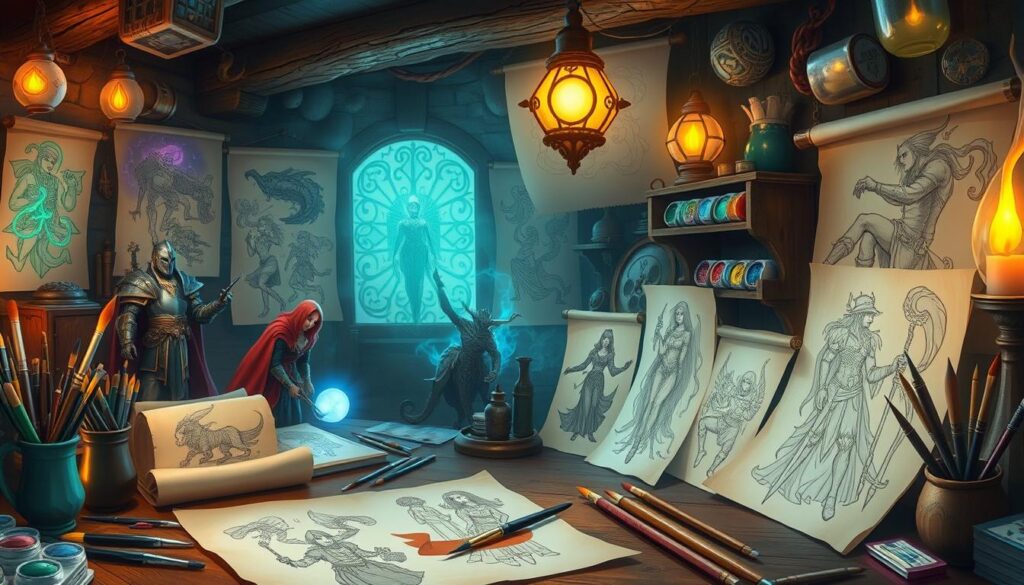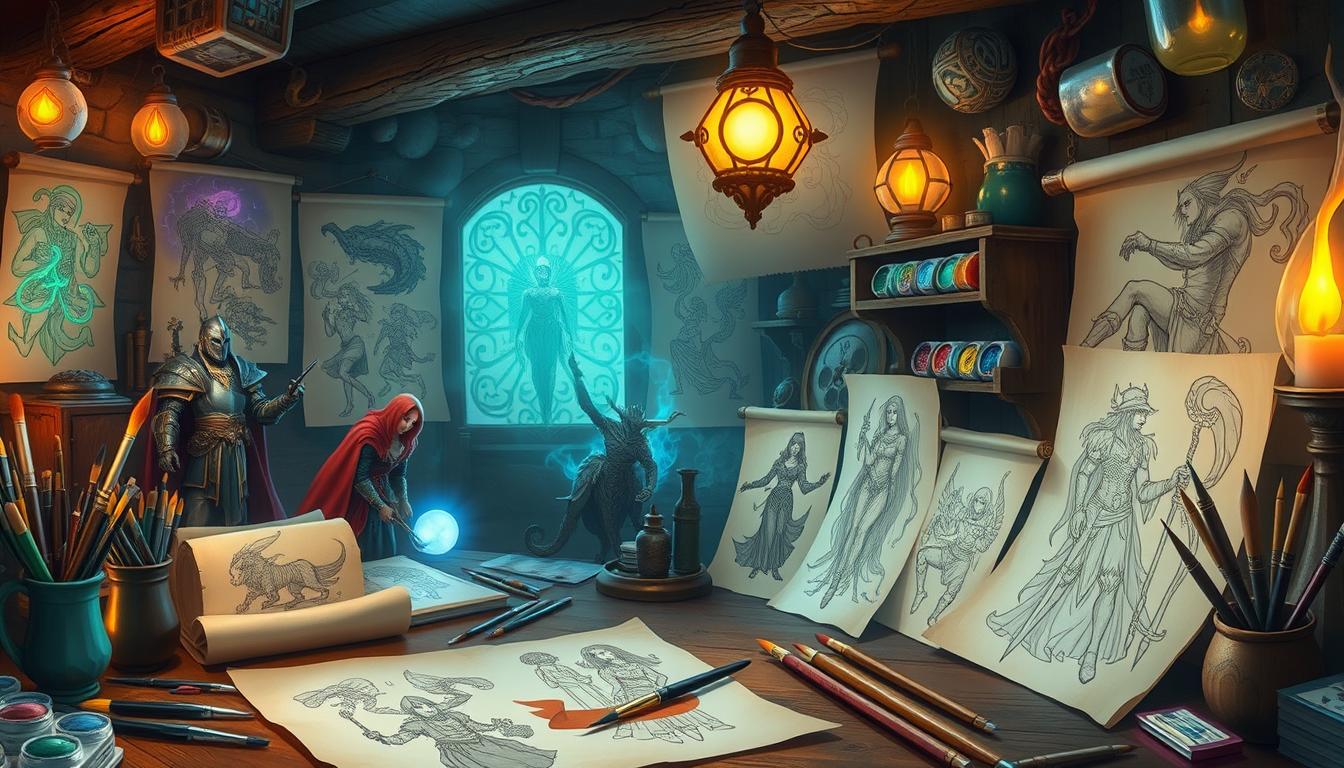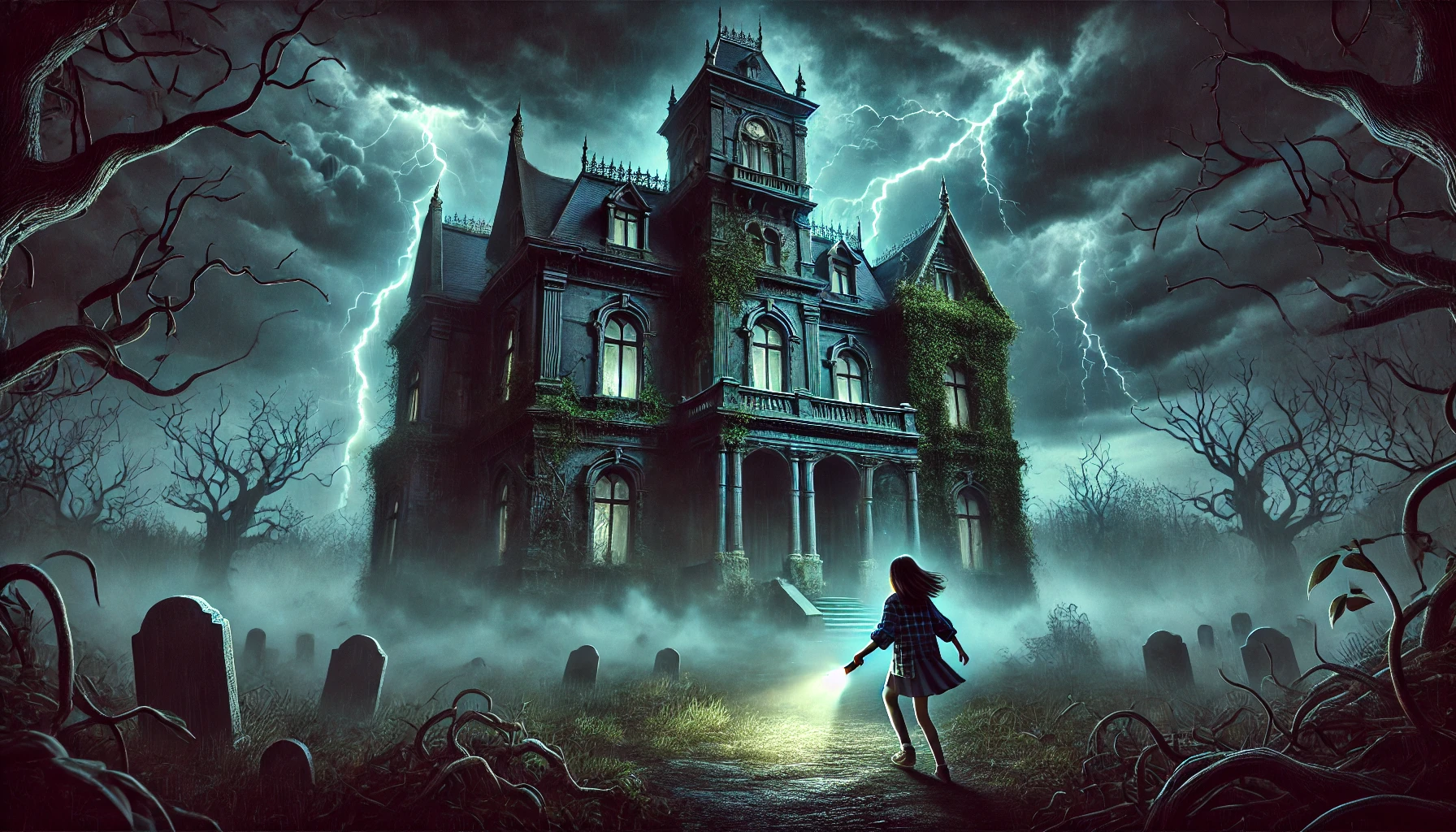Welcome to the magical world of fantasy story writing! This guide is for both new and experienced writers. It aims to spark your creativity and improve your skills in creating memorable stories. You’ll learn key tips for writing epic fantasy tales that grab your readers’ attention.
You’ll dive into various techniques in this guide. Learn how to build detailed worlds and engaging characters. Discover how to create magic systems and control the story’s pace. This article will help you turn your dreams into vivid stories where heroes and villains thrive.

Key Takeaways
- Understand the key elements that define the fantasy genre.
- Create unique and immersive settings for your stories.
- Design characters that resonate with your readers.
- Craft plots filled with conflict and tension.
- Utilize descriptive language to bring your world to life.
- Establish a believable magic system with clear rules.
- Engage readers with effective dialogue and pacing.
Understanding the Fantasy Genre
The fantasy genre is full of wonder, with many fantasy elements that take readers to amazing places. To write great stories, you need to know what makes this genre special. Magic, mythical creatures, and different worlds are key, making stories exciting and full of wonder.
Defining Fantasy Elements
Fantasy elements are the heart of great stories. They include:
- Magic: A key part that can take many forms, shaping the story’s rules and conflicts.
- Mythical Creatures: Creatures like dragons and elves add depth and richness to your world.
- Alternative Realities: Worlds unlike our own offer a chance to explore deep themes.
Knowing these elements helps you write better fantasy stories. It also lets you dive into the deep themes in your story.
Exploring Sub-genres of Fantasy
The fantasy genre has many sub-genres, each with its own charm. Some well-known types include:
- High Fantasy: Known for big quests and detailed worlds, often in different realms.
- Urban Fantasy: Mixes magic with today’s world, making the ordinary magical.
- Dark Fantasy: Blends fantasy with horror, exploring morality and human nature.
Understanding these sub-genres helps you find the right tone and style for your story. Each offers unique chances to explore, keeping your stories fresh and captivating.
Developing Your Fantasy World
Creating a fantasy world is more than just dreaming. You need to focus on the small details that bring your story to life. A unique setting is key to making your story stand out. It should draw readers into your world.
Think about the geography, cultures, and societies of your world. These elements are what make your world feel real.
Creating a Unique Setting
Start by mapping out your world’s geography. Consider everything from mountains to oceans. These landscapes shape your characters’ lives.
Think about the climate, cultures, and economies of your world. These details help create a rich setting.
A unique setting is the foundation of a great fantasy story. It becomes a character in itself, influencing the plot and characters.
Building Consistent Lore and History
A fantasy world needs a deep history to feel alive. Spend time crafting the myths and legends that shape your world. This history adds depth and authenticity to your story.
Consider the origins of nations, the stories of mythical creatures, and the impact of wars. These elements enrich your world and guide your characters.
By weaving this lore into your story, you connect readers to your world. It informs character motivations and can lead to exciting plot twists.
Fantasy Story Writing Essentials
Creating a fantasy story starts with a solid plot. This plot is like a roadmap for your readers, leading them on an exciting journey. It’s filled with elements that grab their attention and keep them hooked. Using key writing techniques helps make your story arc unforgettable for your readers.
Crafting a Compelling Plot
A good plot has many layers, like themes and character conflicts. Adding surprises can make your story even better while keeping it true to itself. Your story should grow naturally, making readers eager for what’s next without feeling forced.
Creating Conflict and Tension
Conflict is key in storytelling because it creates the tension that makes readers want to keep reading. Conflicts can be internal, between characters, or epic battles. They should match with what your characters want and the story’s themes, making the experience richer. Use a table to plan out conflicts and how they’ll be solved, making sure the story flows well.
| Conflict Type | Description | Resolution Strategy |
|---|---|---|
| Internal Conflict | A character struggles with their own fears or doubts. | Develop a supportive secondary character who guides them. |
| Character vs. Character | Two characters have opposing goals leading to confrontation. | Use a climactic scene where both characters face their motivations. |
| Character vs. Nature | Characters confront natural challenges, such as storms or beasts. | Implement a journey of survival where characters learn tactical skills. |
Understanding these elements helps make your fantasy story engaging and memorable. Remember, both conflict and plot are vital for a story that lingers in readers’ minds long after they finish reading.
Character Creation in Fantasy Stories
In fantasy stories, creating characters is key. These characters must be memorable and engaging. They should have rich backgrounds, clear motivations, and unique personalities.
Designing Memorable Characters
To make characters stand out, think deeply about their past and traits. Here are some important points to consider:
- Backstory: Give them a detailed history that shapes who they are today.
- Motivation: Know what pushes them to keep going. This affects how they grow.
- Personality: Each should have traits that make readers feel something.

Character Arcs and Development
Character arcs show how they evolve over time. Good development follows a clear path:
- Introduction: Show who they are and what they want at the start.
- Challenge: Introduce obstacles that make them grow.
- Transformation: Show how they change due to their experiences.
- Resolution: End their journey with clear signs of change.
Creating compelling character arcs makes them relatable. It adds depth to your story. Their stories, filled with ups and downs, connect with readers, making them unforgettable.
| Element | Importance | Example |
|---|---|---|
| Backstory | Provides depth and context | A young sorceress training under a legendary wizard |
| Motivation | Drives character decisions and actions | A knight seeking revenge for lost family |
| Personality | Creates reader attachment | A mischievous thief with a heart of gold |
Fantasy Story Writing Techniques
Descriptive language is key in fantasy writing. It helps create an immersive experience for readers. By using vivid imagery and sensory details, you can take your audience to magical worlds. Different writing techniques can make your story more engaging and keep readers hooked.
Utilizing Descriptive Language
Using descriptive language is more than just painting pictures. It’s about finding the right balance between showing vs. telling. Good storytelling often shows scenes through characters’ feelings and actions, not just telling what’s happening. This makes your characters more relatable to your audience.
Here are some tips to improve your descriptive language:
- Use sensory details: Engage all five senses to create a rich atmosphere. Describe what characters see, hear, smell, taste, and feel.
- Embrace metaphors and similes: These techniques make descriptions more vivid and relatable. They help readers picture your world better.
- Avoid excess exposition: While background details are vital, too much can slow down the story. Find the right moments to share context without losing the pace.
Writers like J.R.R. Tolkien and George R.R. Martin are masters at immersive storytelling. By studying their work, you can learn how to enhance your own writing style.
Writing Believable Magic Systems
Creating a compelling magic system adds depth and intrigue to any fantasy story. Clear rules of magic make it believable, letting readers dive into the world. It also ensures magic enhances the plot without overshadowing character development.
Defining Rules for Your Magic
Setting rules for magic is key. Without them, magic can become too easy, losing the suspense. Here are important things to think about:
- Nature of Magic: Decide if magic comes from ancient texts, natural sources, or personal ability.
- Limitations: Say what magic can’t do. For example, can it revive the dead, or are there big risks for using it too much?
- Cost: Add a cost for using magic. This could be physical, emotional, or a sacrifice of another kind.
- Learning Process: Explain how characters learn and master their magic. Does it need formal training, or can they learn on their own?
Integrating Magic into Your Plot
Magic should blend smoothly into your story. Here are ways to do it well:
- Use magic to help character growth. For example, a character might struggle with their powers and learn from these challenges.
- Make magic a plot tool. Think about how it can create conflict or solve problems without making things too easy.
- Make sure magic adds to your world-building. Show how common magic is in your society and its effects on norms and conflicts.
- Balance magic with other elements, like technology or politics, to make your story rich and complex.

Fantasy Story Writing: Tips for Engaging Readers
Engaging readers is all about finding the right mix of storytelling. This includes how you use dialogue and pacing. Good dialogue helps characters come alive and moves the story forward. It’s important to make sure conversations feel real and add to the story.
Using Dialogue Effectively
Effective dialogue shows what characters are like, how they feel, and what they want. Here are some tips for writing great dialogue:
- Make it natural: Characters should speak in ways that fit their backgrounds and personalities.
- Use subtext: Characters might not always say what they mean. Let their true feelings and motives add tension.
- Vary the pace: Quick, short dialogue can build tension, while longer talks can slow things down when needed.
Maintaining Pacing and Flow
The pace of your story affects how fast or slow it moves. To keep your story flowing well, try these strategies:
- Balance scenes: Mix action with quiet moments to create a good rhythm.
- Transitions matter: Use chapter breaks, scene changes, or line breaks to smoothly change the pace.
- Stay focused: Don’t include too many details that slow down the story.
Conclusion
As you finish your journey in fantasy story writing, remember the key elements that make your story great. Understanding the fantasy genre and creating a detailed world with interesting characters are essential. Each part is vital for a story that pulls readers in.
The conclusion of your story is more than just ending it. It’s the result of your hard work, creativity, and imagination.
Use the tips and techniques we’ve shared to improve your writing. Try out different ways to describe things, create plots that grab attention, and make magic systems that your readers will love. Remember, your unique voice and bold storytelling are what make your tales unforgettable.
Storytelling is a journey that’s both fulfilling and magical. Dive into the creative process, let your ideas run free, and enjoy the magic of bringing your stories to life. With passion and commitment, your writing can take readers on amazing adventures and inspire them to dream big.
FAQ
What are the key elements of fantasy story writing?
Key elements include magic, mythical creatures, and detailed worlds. Complex characters are also important. These elements make stories engaging and memorable for readers.
How do I define my fantasy genre?
To define your genre, look at its core elements. These are magical systems, unique settings, and themes. Exploring sub-genres like high fantasy or dark fantasy can help refine your story.
What makes a compelling plot in fantasy stories?
A good plot has twists, conflicts, and evolving subplots. Focus on character motivations and their journeys. This makes the story more impactful.
How can I create memorable characters?
Create memorable characters by focusing on their backstories and motivations. Their relationships with others are also key. Authentic character development keeps readers interested in their stories.
What are some effective writing techniques for fantasy storytelling?
Effective techniques include descriptive language and balancing showing and telling. Pacing is also important. These elements keep readers hooked and eager to read more.
How do I create a believable magic system?
Create a believable magic system by setting clear rules. Use magic in a way that enhances character arcs and plot. This keeps the story balanced and engaging.
What strategies can I use to keep readers engaged?
Keep readers engaged with natural dialogue and balanced pacing. Create a strong emotional connection through relatable experiences and conflicts. This makes the story more impactful.




